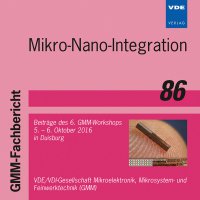Centrifugation of micro particles and self-assembly of nano particles by capillary bridging for 3D thermal interconnects
Conference: Mikro-Nano-Integration - 6. GMM-Workshop
10/05/2016 - 10/06/2016 at Duisburg, Deutschland
Proceedings: Mikro-Nano-Integration
Pages: 6Language: englishTyp: PDF
Personal VDE Members are entitled to a 10% discount on this title
Authors:
Hofmann, Christian; Baum, Mario; Wang, Wei-Shan; Wiemer, Maik (Fraunhofer Institute for Electronic Nano Systems, Chemnitz, Germany)
Abstract:
Efficient heat dissipation is of major importance in advanced packages of high performance integrated circuits (IC’s). To ensure and extend the integration density, 3D chip stacking with multiple silicon dies vertically arranged on top of each other is indispensable. However, these packages require an enhanced thermal management, in order to dissipate the heat from each stacked die to the heat sink. This report presents a process flow for an advanced concept of percolating thermal underfills using the sequential assembly of micron- and nano-sized particles. Due to an improved connection of the micron-sized particles by bridges of a nano-sized material, a highly percolated network with increased thermal paths is obtained. A thermal conductivity of up to 3.8 Wm-1K-1 was already demonstrated for the resulting composite material. This study focuses on three main process steps, the centrifugal filling of microparticles into a defined silicon cavity to form a percolating particle bed, the self-assembly of nanoparticles around the contact points of the microparticles by capillary bridging (so-called neck formation) and the capillary backfilling of the formed particle network with an epoxy. For the centrifugal filling, silica and alumina spheres with diameters ranging from 27 µm to 30 µm and 25 µm to 36 µm, respectively, were dispensed into a rotating filling plate. As a substitute for the solder ball interconnect bond line within a chip stack, fabricated silicon cavities with different pillar layouts are filled with microparticles. The dependencies of the fill fraction, fill front, packing structure and occurring defects on the rotational speed are studied. Particularly, an empty space in the particle bed behind the pillars in fill direction (referred to as shadowing) appeared as defect. Furthermore, the work discusses processing aspects to form necks by capillary bridging between the microparticles. For the initial experiments, metal-based nano-particle inks are assembled into the contact points of the micron-sized spheres, directed by the surface tension during drying. The concentration of the nanoparticle suspension, as well as the drying and sintering temperatures, and times are discussed. In addition, further defects in terms of microparticle rearrangements, voids and air inclusions were detected for different solvents and nanoparticle inks. Finally, the formed particle network is infiltrated by a two component epoxy system. X-ray computed tomography (CT) analysis und SEM images of the cross section of a cavity are used to evaluate the entire composite material.


